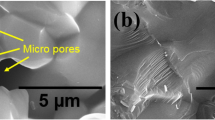Abstract
Remote plasma-enhanced chemical vapor deposition (RPCVD) is a low temperature growth technique which has been successfully employed inin situ remote hydrogen plasma clean of Si(100) surfaces, silicon homoepitaxy and Si1- xGex heteroepitaxy in the temperature range of 150–450° C. The epitaxial process employs anex situ wet chemical clean, anin situ remote hydrogen plasma clean, followed by a remote argon plasma dissociation of silane and germane to generate the precursors for epitaxial growth. Boron doping concentrations as high as 1021 cm−3 have been achieved in the low temperature epitaxial films by introducing B2H6/He during the growth. The growth rate of epitaxial Si can be varied from 0.4Å/min to 50Å/min by controlling therf power. The wide range of controllable growth rates makes RPCVD an excellent tool for applications ranging from superlattice structures to more conventional Si epitaxy. Auger electron spectroscopy analysis has been employed to confirm the efficacy of this remote hydrogen plasma clean in terms of removing surface contaminants. Reflection high energy electron diffraction and transmission electron microscopy have been utilized to investigate the surface structure in terms of crystallinity and defect generation. Epitaxial Si and Si1-xGex films have been grown by RPCVD with defect densities below the detection limits of TEM (~105 cm-2 or less). The RPCVD process also exploits the hydrogen passivation effect at temperatures below 500° C to minimize the adsorption of C and 0 during growth. Epitaxial Si and Si1-xGex films with low oxygen content (~3 × 1018 cm-3) have been achieved by RPCVD. Silicon and Si/Si1-xGex mesa diodes with boron concentrations ranging from 1017 to 1019 cm-3 in the epitaxial films grown by RPCVD show reasonably good current-voltage characteristics with ideality factors of 1.2-1.3. A Si/Si1-xGex superlattice structure with sharp Ge transitions has been demonstrated by exploiting the low temperature capability of RPCVD.In situ plasma diagnostics using single and double Langmuir probes has been performed to reveal the nature of the RPCVD process.
Similar content being viewed by others
References
Y. Ota, Thin Solid Film106, 1 (1983).
B. S. Meyerson, Appl. Phys. Lett.48, 797 (1986).
T. Donahue and R. Reif, J. Appl. Phys.57, 2757 (1985).
T. Yamazaki, S. Watanabe and T. Ito, J. Electrochem. Soc.137, 313 (1990).
T. Shibata and T. Ohmi, J. Electron. Mater.19, 1065 (1990).
L. Breaux, B. Anthony, T. Hsu, S. Banerjee and A. Tasch, Appl. Phys. Lett.55, 1885 (1989).
T. Hsu, L. Breaux, B. Anthony, S. Banerjee and A. Tasch, J. Electron. Mater.19, 375 (1990).
B. Anthony, L. Breaux, T. Hsu, S. Banerjee and A. Tasch, J. Vac. Sci. Technol.B7, 621 (1989).
T. Hsu, B. Anthony, R. Qian, J. Irby, S. Banerjee, A. Tasch, S. Lin and H. Marcus, J. Electron. Mater.20, 279 (1991).
The gas purifier is called “Nanochem” which is a trademark of SemiGas Corp.
T. Niino and T. Tatsumi, Jpn. J. Appl. Phys.29, L1702 (1990).
T. Hsu, B. Anthony, R. Qian, J. Irby, S. Banerjee, A. Tasch, S. Lin and H. Marcus, J. Electron. Mater.20, 279 (1991).
Y. Chabal, G. Higashi, K. Raghavachari and V. Burrows, J. Vac. Sci. Technol.A7, 2104 (1989).
K. V. Ravi, “Imperfections and Impurities in Semiconductor Silicon,” Wiley, New York (1981).
B. S. Meyerson, F. K. LeGoues, T. N. Nguyen and D. L. Har-ame, Appl. Phys. Lett.50, 113 (1987).
J. Comfort and R. Reif, J. Electrochem. Soc.136, 2398 (1989).
B. Meyerson, K. Uram and F. LeGoues, Appl. Phys. Lett.53, 2555 (1988).
B. Anthony, T. Hsu, R. Qian, J. Irby, S. Banerjee and A. Tasch, J. Electron. Mater.20, 309 (1991).
T. Hsu, B. Anthony, L. Breaux, R. Qian, S. Banerjee, A. Tasch, S. Lin and H. Marcus, to be published in Plasma Processing and Synthesis of Materials III, MRS Symp. Proc. Vol. 190 (1991).
B. Anthony, T. Hsu, L. Breaux, R. Qian, S. Banerjee and A. Tasch, J. Electron. Mater.19, 1089 (1990).
Author information
Authors and Affiliations
Rights and permissions
About this article
Cite this article
Hsu, T., Anthony, B., Qian, R. et al. Advances in remote plasma-enhanced chemical vapor deposition for low temperature In situ hydrogen plasma clean and Si and Si1-xGex epitaxy. J. Electron. Mater. 21, 65–74 (1992). https://doi.org/10.1007/BF02670922
Received:
Revised:
Issue Date:
DOI: https://doi.org/10.1007/BF02670922




